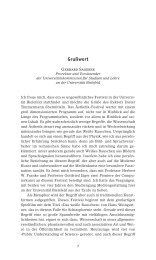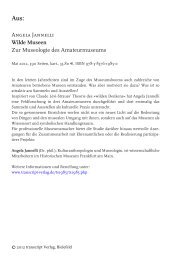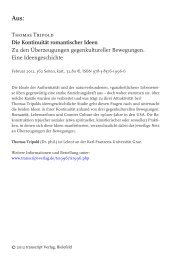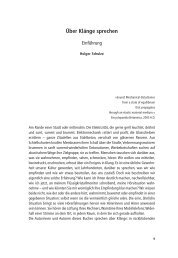Barbara Korte, Eva Ulrike Pirker Black History – White History ...
Barbara Korte, Eva Ulrike Pirker Black History – White History ...
Barbara Korte, Eva Ulrike Pirker Black History – White History ...
You also want an ePaper? Increase the reach of your titles
YUMPU automatically turns print PDFs into web optimized ePapers that Google loves.
From:<br />
<strong>Barbara</strong> <strong>Korte</strong>, <strong>Eva</strong> <strong>Ulrike</strong> <strong>Pirker</strong><br />
<strong>Black</strong> <strong>History</strong> <strong>–</strong> <strong>White</strong> <strong>History</strong><br />
Britain’s Historical Programme between Windrush<br />
and Wilberforce<br />
November 2011, 288 p., 33,80 €, ISBN 978-3-8376-1935-5<br />
Britain’s recent historical culture is marked by a shift. As a consequence of new political<br />
directives, black history began to be mainstreamed into the realm of national history<br />
from the late 1990s onwards. »<strong>Black</strong> <strong>History</strong> <strong>–</strong> <strong>White</strong> <strong>History</strong>« assesses a number of<br />
manifestations of this new cultural historiography on screen and on stage, in museums<br />
and other accessible sites, emerging in the context of two commemorative events:<br />
the Windrush anniversary and the 1807 abolition bicentenary. It inquires into the<br />
terms on which the new historical programme could take hold, its sustainability and<br />
its representational politics.<br />
<strong>Barbara</strong> <strong>Korte</strong> is professor of English Literature at the University of Freiburg, Germany.<br />
<strong>Eva</strong> <strong>Ulrike</strong> <strong>Pirker</strong> is lecturer in English Literary and Cultural Studies at the University<br />
of Freiburg, Germany.<br />
For further information:<br />
www.transcript-verlag.de/ts1935/ts1935.php<br />
© 2011 transcript Verlag, Bielefeld
Contents<br />
Acknowledgments | 7<br />
Note on Citations | 9<br />
Introduction | 11<br />
PART I: BETWEEN PUBLIC AND POPULAR:<br />
APPROACHING A BLACK BRITISH HISTORY<br />
1. Discovering a Past for the Present | 17<br />
2. Historical Culture and Social Communication | 37<br />
3. Popular Re/Presentation of <strong>History</strong> and Its Media | 47<br />
4. Key Aims and Questions | 53<br />
PART II: THE BICENTENARY EFFECT: HOW THE SLAVE<br />
TRADE, SLAVERY AND ABOLITION WENT PUBLIC<br />
1. Remembering and Forgetting Slavery | 57<br />
2. Screening Slavery and the Slave Trade<br />
before the Bicentenary | 65<br />
3. Simon Schama’s Rough Crossings:<br />
From Popular <strong>History</strong> Book to Television <strong>History</strong> | 81<br />
4. The Abolition as Costume Film:<br />
Amazing Grace <strong>–</strong> <strong>Black</strong> <strong>History</strong> with a <strong>White</strong> Hero | 99<br />
5. Setting a Critical Tone:<br />
In Search of William Wilberforce | 115
6. ›Doing an Anniversary‹:<br />
The Event Culture Surrounding 2007 | 121<br />
7. The Impact of 2007 <strong>–</strong><br />
Slavery and the Slave Trade in British Museums | 135<br />
8. Family Matters:<br />
Genealogy as Popular (<strong>Black</strong>) <strong>History</strong> | 163<br />
PART III: KEEPING POST-WAR MIGRATION VISIBLE:<br />
THE WINDRUSH STORY IN THE TWENTY-FIRST<br />
CENTURY<br />
1. Screening and Staging an Arrival | 183<br />
2. Family, Sport and Period in Wondrous Oblivion | 185<br />
3. Notting Hill in a Historical Crime Serial | 199<br />
4. Migration as Heritage Drama? Small Island | 207<br />
5. Migration <strong>History</strong> as Entertainment?<br />
Trends in Contemporary British Theatre | 231<br />
6. The Windrush Story as Musical | 239<br />
Conclusion | 251<br />
Bibliography | 255<br />
Index | 279
Introduction<br />
<strong>History</strong> is a contested field whose images and narratives emerge to a considerable<br />
extent from discursive processes. In Western societies today we<br />
can observe a pronounced need for and an increased »consumption« of<br />
history (cf. De Groot 2009). As a consequence of this demand, histories are<br />
increasingly being produced and made available in ways that <strong>–</strong> rather than<br />
speaking to specialists or special interest groups <strong>–</strong> are accessible to wider<br />
audiences. 1 The general audience’s interest, it seems, can be taken for<br />
granted and is served on the cultural market. Like other countries, the<br />
United Kingdom has been experiencing a conspicuous peak of historical<br />
interest since the end of the twentieth century, as David Cannadine remarks:<br />
»In Britain, the late 1990s and early 2000s witnessed what was widely regarded as<br />
an unprecedented interest in history; among publishers, in the newspapers, on radio<br />
and on film, and (especially) on television; and from the general public who, it<br />
seemed, could not get enough of it. Translated into the market-orientated language<br />
of our day, it looked as though more history was being produced and consumed than<br />
ever before.« (Cannadine 2004: 1)<br />
Reasons for this history boom suggested by Cannadine include, among<br />
others, »unprecedented outbursts of national retrospection« (for instance on<br />
the occasion of the Queen Mother’s death in 2002) or the sheer availability<br />
1 Of course, such audiences display, in themselves, a high heterogeneity in terms<br />
of class, age, gender and ethnicity. It is a cross-section of such audiences that<br />
products aimed at a ›general‹ or ›mainstream‹ audience usually try to reach.
12 | BLACK HISTORY <strong>–</strong> WHITE HISTORY<br />
of historical information through the revolution in information technology.<br />
In addition, history has become a major entertainment source, not only on<br />
television but also in literature or in themed environments and special<br />
events. The possible motives for the contemporary historical interest are<br />
plenty and difficult to concretise, but they can be seen as an indicator of an<br />
intensified need for orientation. Definitions and explanations of belonging<br />
and identity are sought in a world that has become more complex in a short<br />
period of time due to rapid changes. The »patterns of understanding« we<br />
construct for the past can help us to »explain the origins and nature of the<br />
world in which we live. And doing this, we define and redefine the place<br />
that we occupy in that world.« (Morris-Suzuki 2005: 2f.) What must engage<br />
us when we consider history, therefore, are not only its many forms,<br />
but also the diverse functions which history fulfils in various societies. The<br />
term ›historical culture‹ is increasingly used for the ways in which societies<br />
make certain segments of the past significant and useful for their present<br />
concerns and interpretative needs. »Cultures of history«, according to Billie<br />
Melman (2006: 11), are »cultures at work«; they make »versions of history<br />
meaningful and workable for individuals within the constrictions of society,<br />
the economy, and the state«, and they do so »both in a social and material<br />
world and in their imaginary« (Melman 2006: 4). Historical cultures today<br />
draw from a wide range of media and forms, notably those with a mainstream<br />
or even ›popular‹ appeal. 2<br />
The particular interest of this book is the ways in which a black history<br />
has been made accessible and relevant to a wider audience in the<br />
United Kingdom in recent years. This history <strong>–</strong> like black British culture in<br />
general <strong>–</strong> has become the subject of intensified academic activity. 3 How-<br />
2 The popularisation of historical knowledge is an expanding but diffuse field of<br />
research. Cf. the surveys provided by <strong>Korte</strong>/Paletschek (2009a; 2011) and Berger/Lorenz/Melman<br />
(2011). The term ›popular‹ is a contested term and this<br />
book cannot review the debates surrounding it in depth. It should be noted,<br />
however, that no cultural product is inherently popular; its popularity depends<br />
on cultural contexts and processes that make a product popular.<br />
3 Cf., for instance, the pioneering studies of Walvin (1971; 1973) and Shyllon<br />
(1974; 1977), later continued, among others, by Edwards/Walvin (1983), Fryer<br />
(1984), Dabydeen (1985), Dabydeen/Wilson-Tagoe (1987) and, again, Walvin<br />
(1984; 1986). An important impetus for further research was provided by the
INTRODUCTION | 13<br />
ever, treatments of this history which address a non-specialist audience<br />
have a particular capacity to disseminate knowledge about the longstanding<br />
presence of black people in the national past and anchor it in the<br />
national historical consciousness. This is seminal in a society which has<br />
begun to identify itself as a multiethnic society. However, in many of the<br />
recent ›popular‹ representations, black history still emerges as contested,<br />
and the choices of whether, and how, to address its complexities vary considerably.<br />
To do justice to this variety, we approach our subject through a<br />
number of case studies of presentations that come in different media and<br />
genres and display different perspectives on black history. They all date<br />
from the now already historical period during which a New Labour Government<br />
promoted ›multiethnicity‹ and hence gave impetus to revisions of<br />
the nation’s historical culture.<br />
Part I provides essential background information and the basic premises<br />
of the present study: a survey of the promotion of black history in the<br />
British public and its establishment as an essential component of a new<br />
historical culture for a ›multiethnic Britain‹, as well as our main conceptual<br />
framework and terminology. The case studies in Parts II (on the British<br />
slave trade and its abolition) and III (on post-Second World War migration<br />
from the Caribbean) constitute the core of this book. They concentrate on<br />
those two segments of black British history which have received the biggest<br />
share of public attention over the past years. Both were articulated on the<br />
occasion of prominent anniversaries in 1998 and 2007 respectively: the<br />
fiftieth anniversary of the arrival of the Empire Windrush from the Carib-<br />
1981 International Conference on the <strong>History</strong> of <strong>Black</strong>s in Britain, which was<br />
accompanied by a special issue of <strong>History</strong> Today (The <strong>History</strong> of <strong>Black</strong>s in<br />
Britain 1981). Race relations have been a dominant theme in research from the<br />
1990s onward (cf. Goulbourne 1998; Miles 1993). Another area that was<br />
investigated in more depth was the black presence in Britain during the slave<br />
trade and the colonial past (cf. Morgan/Hawkins 2004; Myers 1996; Okonon<br />
1998 and Walvin 1992; 1998; 2006; 2007). Yet the field still remained<br />
fragmented until the publication of The Oxford Companion to <strong>Black</strong> British<br />
<strong>History</strong> (Dabydeen/Gilmore/Jones 2007), the first encyclopaedia comprising information<br />
about historical figures, key terms and movements. For an assessment<br />
of the emergence of narrative (factual and fictional) discourses surrounding a<br />
black British history cf. <strong>Pirker</strong> (2011a).
14 | BLACK HISTORY <strong>–</strong> WHITE HISTORY<br />
bean, and the bicentenary of the abolition of the slave trade. 4 That anniversaries<br />
can function as triggers for the inclusion of new themes in a nation’s<br />
historical culture brings up questions with regard to the sort of history that<br />
is represented or performed for a wider audience: Which anniversaries are<br />
taken up in the first place, when, where and why? Who are the agents that<br />
bring about, take part in and consume historical celebrations? Which<br />
anniversaries (or commemorative events more generally) compete with or<br />
dominate over others and why? These as well as other related questions are<br />
considered in several chapters of this book, which otherwise provide close<br />
critical readings of the cases investigated. Taken together, the analyses in<br />
Parts II and III give insights into what is a highly diverse and contested<br />
historical culture, regardless of the fact that in all cases a ›general‹ audience<br />
was the intended addressee. The comparison of the popularisation of the<br />
Windrush story with the recent narratives around slavery and abolition also<br />
raises the question as to what kind of black history it is that ›suits‹ the<br />
recent historical culture of Britain best.<br />
4 For research into the significance of anniversaries and celebrations in historical<br />
culture cf., among others, Johnston (1991), the survey by Macho (1998), the<br />
studies by Chase (1990) and Botstein (1997) and the contributions by Ben-<br />
Aaron, Katriel and Sarangi to a themed issue of the journal Text (September<br />
2005).

















